Homemade Rose Syrup Recipe for Coffee (Easy & Floral DIY)
Last updated on August 12th, 2025 at 03:20 pm
Ever feel like your coffee routine is stuck in a loop? I mean, same flavors, same thing, nothing new?
I used to think rose water belonged in perfume, not in my cup. The first time I heard someone say “rose latte,” I winced. But curiosity got the best of me. I followed a YouTube recipe (it flopped hard), yet something about the idea stuck. There was potential… I just had to tweak it.
That’s how I ended up learning how to make rose syrup at home. It’s an easy way to turn your coffee into something completely different.
In this post, I’ll walk you through the simple ingredients, how to make it step-by-step, creative flavor twists, and some drink ideas to try out. So let’s start brewing!
Got a thing for sweet, spicy, or sugar-free? These top syrup brands might just be your new favorites.
What Is Rose Syrup in Coffee?
It’s made by steeping rose petals or using rose water, then simmering it with sugar until it turns into a smooth, fragrant syrup. The beauty of rose syrup is how it mellows out strong espresso or cold brew.
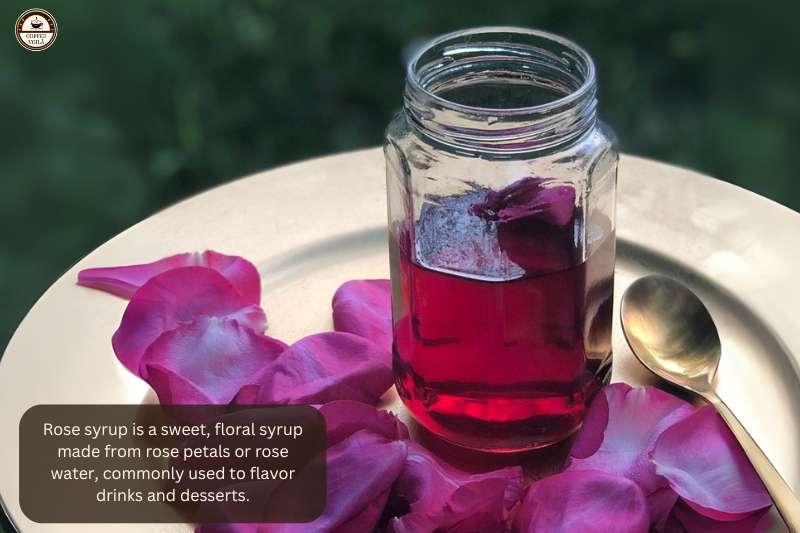
If you’re someone who finds straight coffee too bitter or intense, adding a splash of rose syrup can round out those sharp notes. It gives your drink a smoother finish.
I like the fact that the flavor from this syrup isn’t as overpowering as some other ones. Instead, it adds enough sweetness and aroma to make your coffee taste great, even when you’re sipping it out of a to-go mug.
This combo isn’t new…
The fact is, Rose and coffee are old friends in Middle Eastern traditions, especially in Turkish or Lebanese-style drinks and desserts.
These days, you’ll spot rose lattes and rose-cardamom drinks in modern cafés too. It’s the kind of syrup that feels both classic and trendy at the same time, and once you try it, you’ll get why it’s become a favorite for many coffee lovers.
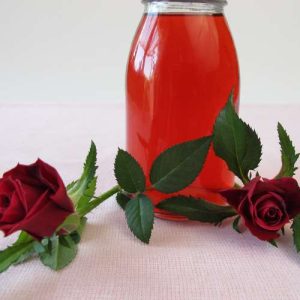
How to Make Rose Syrup (Step-by-Step)
Equipment
- Small Saucepan:
- Fine-Mesh Strainer or Cheesecloth:
- Measuring cups and spoons
- Heatproof spoon for stirring
- Clean glass bottle or jar for storage
Ingredients
- Dried edible rose petals (1/4 to 1/3 cup) or 2–3 tablespoons culinary rose water
- 1 cup white sugar (or cane sugar for a more natural flavor)
- 1 cup water
- Optional: a splash of beet juice or hibiscus for pink color
- Optional: a drop of vanilla extract or lemon zest for depth
Instructions
- Step 1) Make a Rose Infusion: Bring 1 cup of water to just below a boil, then remove from heat. You then add your rose petals and let them steep for 5–10 minutes, longer if you want a stronger aroma. If you’re using rose water, you can skip the steeping and move straight to the next step.
- Step 2) Add Sugar and Simmer: Strain out the rose petals using a fine mesh strainer or cheesecloth. Next, pour the rose infusion back into the pan, add the sugar, and stir gently over low heat. Let it simmer (not boil) until the sugar completely dissolves and the syrup thickens a little. This usually takes about 5–8 minutes.
- Step 3) Cool and Bottle: Take the syrup off the heat and let it cool completely at room temp. Once it’s no longer warm, pour it into a clean bottle or jar. Afterward, store it in the fridge and use it within 2 to 3 weeks. It’s normal if it separates a bit. Just give it a shake before using.
Video
How to Use Rose Syrup in Coffee?
Here are my favorite ways to sneak that floral flavor into everyday sips and treats.
Lattes or Iced Coffee
This is where rose syrup shines. I usually start with one tablespoon and stir it into a vanilla latte or a simple iced espresso. It adds a soft floral sweetness without overpowering the coffee’s richness.
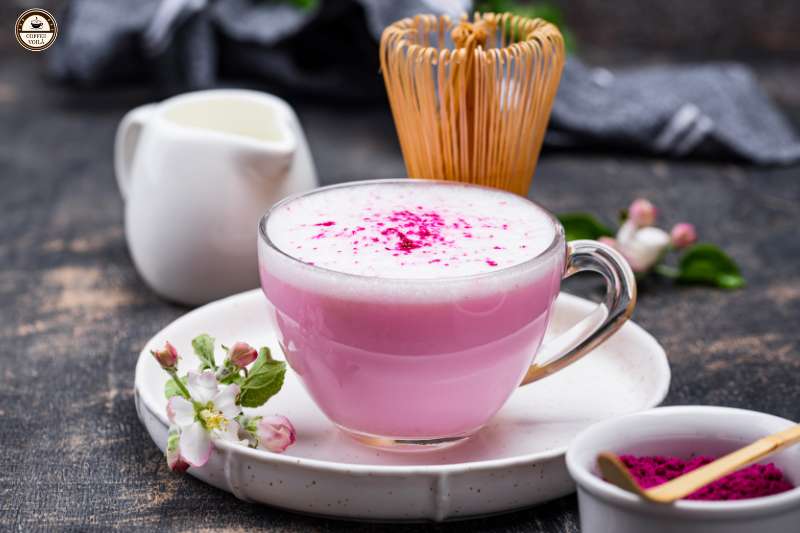
Pairs Especially Well With Milk-Based Drinks
If you’re using dairy milk, oat, or even coconut, that creaminess balances the rose flavor so well. I find oat milk is the winner here. It’s my favorite option when I want a cozy but unique treat.
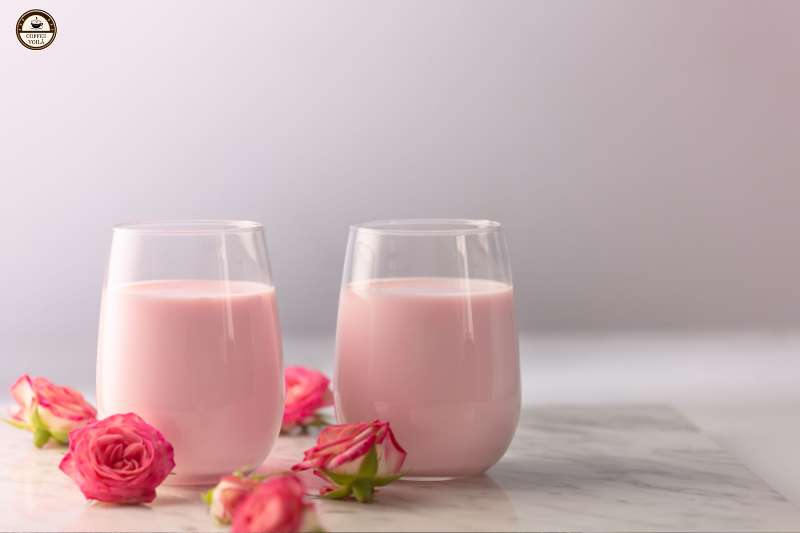
Use in Cold Brew or Rose-Cardamom Coffee
For a bolder flavor, mix it into cold brew or even brew a strong coffee with cardamom pods and then add rose syrup. You get a warm, floral, and slightly spiced drink that’s great for sipping slowly on a lazy afternoon.
Tea, Cocktails, Lemonade, or Desserts
The rose syrup in chilled green tea or lemonade is refreshing. I’ve also drizzled it over vanilla ice cream or mixed a splash into gin with lemon juice for a really lovely floral cocktail. It’s surprisingly versatile once you start playing around with it.
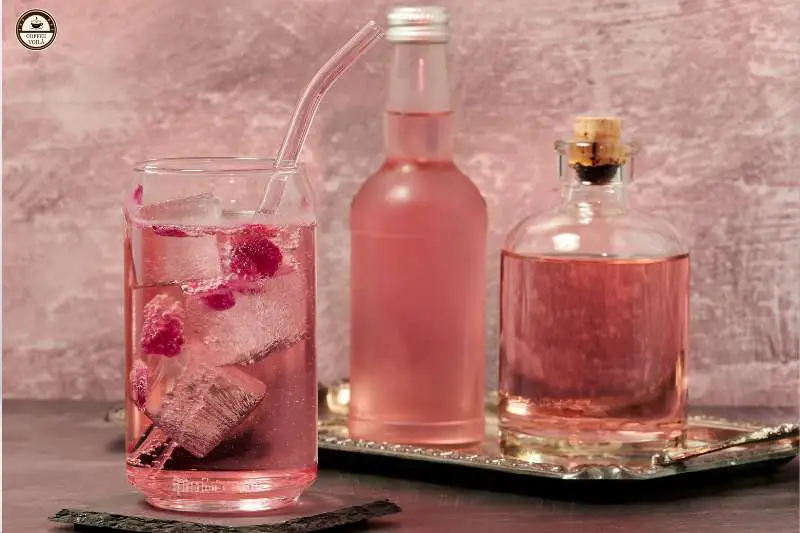
Rose Syrup in Coffee: Tips and Variations
These are a few tips I’ve learned from trial and error (and a few syrup fails that went straight down the drain).
Use Culinary-Grade Rose Water If You Can’t Find Petals
When I don’t have dried rose petals on hand, I reach for Cortas Rose Water. It’s affordable, fragrant, and easy to find in Middle Eastern stores or online. Just make sure whatever brand you use says “culinary grade” on the label. Some rose waters are meant for skincare, and you certainly don’t want that in your coffee.
For a Stronger Aroma, Steep Longer or Double the Petals
The first time I made rose syrup, it smelled amazing during steeping but tasted like barely-sweet water. Now I always steep at least 10 minutes and double the amount of petals if I want that café-level floral hit. It makes a big difference, especially if you’re pairing it with bold espresso.
Add a Touch of Cardamom or Vanilla for Complexity
This part’s optional, but it changes the flavor completely. A tiny pinch of ground cardamom or a splash of vanilla gives the syrup this warm, and exotic edge. I’ve also tried lemon zest. This helps to brighten things up if you prefer a fresher finish.
Create a Sugar-Free Version with Monk Fruit Sweetener
If you’re cutting back on sugar, monk fruit sweetener works pretty well in this syrup. It dissolves similarly to sugar and doesn’t leave that weird aftertaste some substitutes have. Just keep an eye on it while it simmers. It tends to thicken a little faster than the regular stuff.
Last Thoughts
So, have you ever tried rose in your coffee? Go below and drop your favorite combo in the comments. I’d love to hear how you’re using it. And with that… voilà!







